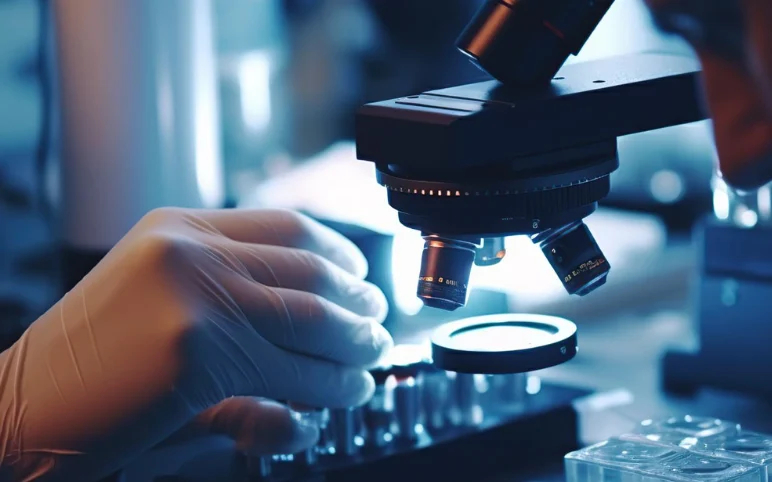US FDA grants 510(k) clearance to Motus GI’s Pure-Vu EVS System
On February 15, 2022, The Pure-Vu® EVS System received 510(k) clearance from the US Food and Drug Administration, according to Motus GI Holdings, Inc., a medical technology company that provides endoscopy solutions that improve clinical outcomes and increase cost-efficiency in the diagnosis and management of gastrointestinal conditions. The new Pure-Vu EVS System is designed to speed up set-up, improve navigation in convoluted anatomy, expand on the Pure-Vu system’s superior cleaning capabilities, and enable physicians to quickly overcome the obstacles of poorly prepared colons during a colonoscopy.
Tim Moran, Chief Executive Officer commented, “We believe our Pure-Vu EVS system now offers physicians the right tool to help address challenging colonoscopy procedures. The development and innovation we’ve implemented in Pure-Vu EVS is the result of listening to valuable feedback from leading physicians and clinical staff that have utilized our Pure-Vu platform. This FDA clearance of Pure-Vu EVS is expected to allow a greater number of physicians and hospitals to bring this important technology to their patients. We believe the Pure-Vu EVS enhances every aspect of our system from the speed of set-up to procedural ease-of-use, while also offering optimized navigation, handling, and cleaning capacity. Additionally, the new EVS oversleeve is able to be loaded on a ‘dirty’ scope in the procedure room, an important new capability that will allow broader utilization of Pure-Vu to help physicians complete difficult cases and better visualize the colon mucosa. We have also implemented an improved manufacturing cost structure that we believe better positions the Company to broaden commercial utilization, improve margins and establish distribution relationships in more cost-sensitive global markets over time.”
The commercial launch of the Pure-Vu EVS in the first quarter of 2022 is anticipated to accelerate the speed of adoption in the US and global markets over time. In addition, the advancements made by the Pure-Vu EVS are expected to support future innovation and indication expansion of the Pure-Vu platform.
According to DelveInsight’s “Gastroendoscopes Market” report, the global Gastroendoscopes market was valued at USD 3.08 billion in 2020, growing at a CAGR of 6.69% during the forecast period from 2021 to 2026 to reach USD 4.53 billion by 2026. The Gastroendoscopes market is witnessing a positive market growth owing to the factors such as the increasing prevalence of various Gastrointestinal diseases such as gastro-oesophageal reflux disease (GORD), growing prevalence of stomach cancer and oesophageal cancer, rising cases of gastrointestinal procedures among the geriatric population, and rapid product development activities with respect to Gastroendoscopes among others.
Invitae Launches its First CE-IVD Cancer Testing Kits In Europe
On February 16, 2022, FusionPlex Dx® and LiquidPlex DxTM, part of Invitae’s industry-leading Anchored Multiplex PCR chemistry in-vitro diagnostic (IVD) technologies, were made available in Europe, according to the firm. Invitae is a leading provider of high-quality precision oncology innovation in the battle against cancer.
Vishal Sikri, President of Oncology at Invitae, said, “This is a major step toward our mission to bring comprehensive genetic information into mainstream medicine. Our best-in-class FusionPlex® and LiquidPlex™ tests will enable more patients access to the right cancer therapies at the right time, which is especially critical in Europe where the majority of molecular testing is performed locally in decentralized hospital settings.”
He further added, “With Invitae’s simplified workflow and reporting solutions, both tests will enable any facility with sequencing technology, combined with our solutions, to accurately profile solid tumors using tissue or blood samples for therapy selection. Precision medicine has increasingly delivered better outcomes for many cancer patients over the last several years. Molecular pathology has never been more important as the fight against cancer shifts towards precision oncology and targeted therapies based on genomic testing. Yet globally, access to the exponentially increasing therapy options is not guaranteed.”
In line with ESMO guidelines for non-small cell lung cancer (NSCLC), Invitae’s FusionPlex® Dx and LiquidPlex™ Dx allow comprehensive genomic profiling (CGP) and companion diagnostic (CDx) use for solid tumor neoplasms including NSCLC in tissue biopsy and where tissue is a limiting factor. The panels are intended to be used on Illumina’s Next Generation Sequencing (NGS) platforms for IVD testing.
- In RNA obtained from formalin-fixed, paraffin-embedded tumor tissues, FusionPlex® Dx detects structural variations, including fusions. FusionPlex® Dx covers multiple actionable variants in a 41-gene panel to provide CGP for patients with solid malignant neoplasms. FusionPlex® Dx is designed to be used as a CDx to help identify patients with NSCLC who have mesenchymal-epithelial transition factor (MET) exon 14 (METex14) skipping alterations, anaplastic lymphoma kinase (ALK) fusions, ros proto-oncogene 1, receptor tyrosine kinase (ROS1) fusions, ret proto-oncogene (RET) fusions, neurotrophic receptor tyrosine kinase 1-3 (NTRK1, NTRK2, NTRK3) fusions, and for whom treatment with targeted therapy may be beneficial.
- In cell-free circulating tumor DNA (ctDNA) extracted from plasma generated from whole blood of cancer patients (liquid biopsy), LiquidPlexTM Dx detects substitutions and insertion-deletion mutations. For individuals with solid malignant neoplasms, LiquidPlexTM Dx examines 29 genes to offer CGP. LiquidPlexTM Dx is designed to be used as a CDx to help identify individuals diagnosed with NSCLC who have METex14 skipping mutations and who could benefit from targeted therapy.
According to DelveInsight’s “In-Vitro Diagnostics (IVD) Market” report, the global in-vitro diagnostics market was valued at USD 67.82 billion in 2020, growing at a CAGR of 4.17% during the forecast period from 2021 to 2026, in order to reach USD 86.35 billion by 2026. The in-vitro diagnostics market is estimated to register positive revenue growth owing to the factors such as the rising prevalence of various infectious diseases such as COVID-19, growing prevalence of various cancers, increasing cases of hematological diseases, and increasing product development activities with respect to in vitro diagnostics among others.
EvoEndo Announces US FDA 510(k) Clearance for Single-Use Unsedated Transnasal Endoscopy (TNE) System
On February 17, 2022, EvoEndo®, Inc., a medical device firm that develops systems for Unsedated Transnasal Endoscopy (TNE), announced that the EvoEndo® Single-Use Endoscopy System received 510(k) approval from the US Food and Drug Administration (FDA). The clearance comes after EvoEndo signed a distribution deal with Micro-Tech Endoscopy USA, Inc., which will begin a phased rollout of the EvoEndo System in hospitals and ASCs across the United States.
Heather Underwood, Chief Executive Officer at EvoEndo, commented, “Receiving FDA 510(k) clearance for the EvoEndo System will allow us to execute on our mission of enabling a safer, faster, and more affordable alternative to sedated endoscopy for both pediatric and adult patients. This is an exceptional accomplishment for our team and validates our ongoing commitment to transform best practices in endoscopy and support the broader adoption of unsedated procedures throughout the U.S.”
Micro-Tech USA President Chris Li stated, “The EvoEndo® Model LE Single-Use Gastroscope addresses critical clinical needs in current pediatric and adult endoscopy practice and is a prime example of the innovative medical technology we strive to provide to our network. A combination of the smaller scope size, larger biopsy channel, coupled with a sterile single-use device can help save valuable procedure time and cost. We look forward to further growing our partnership with EvoEndo and to the successful completion of initial clinical cases.”
The EvoEndo System combines sterile, single-use, flexible endoscopes, a portable video controller, and a take-home “comfort package” incorporating virtual reality (VR) goggles for patient enjoyment and diversion during the treatment to enable unsedated transnasal endoscopy. Patients, physicians, and hospitals will benefit from the EvoEndo System because it makes upper endoscopic operations safer and more cost-effective. The FDA approval is the most recent achievement for EvoEndo, which also announced the closing of a USD 10.1 million equity fundraising round in June.
According to DelveInsight’s “Disposable Endoscopes Market” report, the global disposable endoscopes market was valued at USD 1.50 billion in 2020, growing at a CAGR of 12.44% during the forecast period from 2021 to 2026 to reach USD 3.03 billion by 2026. The demand for disposable endoscopes is primarily being boosted by the increasing prevalence of various disorders related to the gastrointestinal tract, respiratory tract, and others amongst the population and the onset of the COVID-19 pandemic that has raised the market for disposable endoscopes contributing to the overall growth of the disposable endoscopes market during the forecast period from 2021-2026.
PolyActiva Announces Positive Phase IIa Trial Results in Low Dose Cohort for PA5108 Ocular Implant with Prezia™ Sustained Drug Delivery Technology
On February 17, 2022, PolyActiva Pty Ltd, a clinical-stage Australian biopharmaceutical company focused on developing unique biodegradable ocular implants with sustained drug delivery for patients suffering from ophthalmic diseases such as glaucoma, announced that the Phase IIa study of its PA5108 Ocular Implant for Primary Open-Angle Glaucoma (POAG) treatment met both the study’s primary and secondary efficacy endpoints of at least 20% IOP lowering in its low dose cohort. Results from the study were presented by Russell Tait, Ph.D., Chief Executive Officer of PolyActiva, at the 11th Annual Glaucoma 360 New Horizons Forum in San Francisco, CA.
Associate Professor Michael Coote, MD, a leading glaucoma specialist at Melbourne Eye Specialists and a principal investigator of the study, commented, “The results of the low dose cohort demonstrate that the implant achieves a clinically meaningful IOP-lowering effect. The PA5108 Ocular Implant with Prezia Sustained Drug Delivery Technology may provide a significant advancement in the treatment of glaucoma with the laudable goal of enabling a constant dose of medication for six months via a safe and effective biodegradable implant.”
Topline Phase IIa trial results in low dose cohort:
- Statistically significant IOP reduction vs. baseline of a >20% IOP-lowering effect (p<0.001 and P<0.01) across all assessment visits.
- Statistically significant and clinically meaningful mean change in diurnal IOP at 12 and 26 weeks (p<0.001).
- Implant persistence through a minimum of 21 weeks with full implant biodegradation by week 40, over a 4-6 week period.
- Low dose implant was shown to be generally well-tolerated with no ocular serious adverse events related to the product, no endothelial cell loss, and no implant movement.
Russell Tait, stated, “We are excited to announce these positive Phase IIa results as they point to the significant benefit the PA5108 Ocular Implant with Prezia Technology may provide to the ophthalmic community and patients suffering from the effects of glaucoma. We look forward to further exploring its beneficial clinical impact as we move to the next phase of our clinical program.”
The open-label, multicenter Phase IIa research was meant to determine the PA5108 Ocular Implant’s minimal effective dosage in individuals with mild to moderate POAG across three dosing groups (10 subjects per cohort). Mean diurnal IOP at 12 and 26 weeks compared to baseline, as well as 8 am IOP at 6, 18, and 21 weeks compared to baseline, are primary and secondary efficacy objectives. The PA5108 Ocular Implant uses the PreziaTM Sustained Drug Delivery Technology to deliver a consistent daily dose of latanoprost free acid and is designed to have features not found in traditional blend technologies, such as zero-order drug release and rapid, complete, non-toxic biodegradation soon after treatment is completed. The Prezia Technology is adaptable, allowing it to administer numerous medications in a single implant and allowing it to be utilized in both the front and rear of the eye.
According to DelveInsight’s ‘Injectable Drug Delivery Devices Market” report, the global Injectable Drug Delivery Devices Market was valued at USD 17.65 billion in 2020, growing at a CAGR of 11.25% during the forecast period from 2021 to 2026, to reach USD 33.37 billion by 2026. The demand for Injectable Drug Delivery Devices is primarily witnessing growth on account of the increasing incidences of chronic conditions such as cancer, diabetes, and cardiovascular disorders among others, increase in demand for self-injectors, increase in biologics and biosimilar market, rising need and demand for patient compliance to treatment and the rising innovations and technological advancement in this arena.
Ra Medical Systems Provides an Update on Enrollment in Its Pivotal Atherectomy Clinical Trial
On February 18, 2022, Ra Medical Systems, Inc., a medical device company focused on developing its excimer laser system to treat vascular diseases, announced that enrollment in its pivotal clinical trial to assess the safety and effectiveness of the DABRA excimer laser system as an atherectomy device for the treatment of peripheral arterial disease (PAD) has reached 95 subjects. The business also reported that the US Food and Drug Administration (FDA) has approved an increase in subject enrolment from 100 to 125.
Will McGuire, Ra Medical Systems CEO said, “Our request to increase subject enrollment in the atherectomy trial was primarily due to subject fallout for follow-up visits during the ongoing COVID-19 pandemic. To this end, we are pleased the FDA has approved our protocol amendment. We are excited about the opening of two additional clinical sites in late 2021, both with lead investigators who are highly regarded interventional cardiologists, which brings the number of sites qualified for this trial to seven. We expect one additional site, also led by an interventional cardiologist thought leader, to be qualified in the near term. The opening of these new sites is encouraging, yet due to the pandemic we are unable to provide a precise timeline for full enrollment.”
He further added, “There is no question that obtaining FDA clearance for an atherectomy indication for the DABRA excimer laser system is among our top priorities. We significantly expand our addressable market with this clearance. A third-party research group estimates the value of the combined chronic total occlusion (CTO) and atherectomy markets in the US at approximately $900 million for 2022, with atherectomy representing more than $700 million.”
The FDA has approved DABRA for crossing CTOs in patients with symptomatic infrainguinal lower extremity vascular disease, and it is designed for use in occlusive peripheral vascular disease to ablate a channel. Subjects with symptoms of PAD (Rutherford Class 2-5) can be enrolled in the open-label pivotal atherectomy clinical study at up to ten sites. Safety, acute technical success and clinical success are all outcome metrics. The main effectiveness endpoint in the trial is the mean reduction in percent diameter stenosis in each patient’s primary lesion as assessed by angiography immediately after DABRA therapy and before any supplementary treatment. Major adverse events at 30 days post-procedure and the incidence of primary target lesion revascularization at six months are the trial’s safety and clinical success outcomes.
According to DelveInsight’s “Peripheral Artery Disease and Stenosis Treatment Devices – Market” report, as per Centers for Disease Control and Prevention, 2021 statistics, approximately 6.5 million people age 40 and older in the United States have PAD in 2021. The demand for Peripheral Artery Disease and Stenosis Treatment Devices is primarily witnessing growth on account of the rise observed in cardiovascular and peripheral vascular diseases prevalence, as well as the approval of new and improved products by market players along with the rising frequency of lifestyle disorders such as diabetes and hypertension.
Orthofix Expands Synthetic Bone Growth Offerings with Full Market Launch of Opus BA – a Bioactive Solution for Spine Procedures
On February 22, 2022, The full market release of OpusTM BA, a synthetic bioactive bone graft solution for cervical and lumbar spine fusion surgeries, was announced by Orthofix Medical Inc., a worldwide medical device business with a spine and orthopedics focus.
President of Orthofix Global Spine Kevin Kenny, said, “Bioactive synthetics are a very large and growing market. We recognize that each bone substitute has its own unique advantages and surgeons have different preferences when evaluating the use of autologous, allogeneic, or synthetic bone graft materials for their patients. The addition of Opus BA is another example of our commitment to providing surgeons with a wide range of solutions so they can select the best bone substitute for each patient.”
Opus BA, which comes in putty and strip forms, can be used to replace bone voids or gaps in the skeletal system that aren’t essential to the bony structure’s stability. Opus BA works as a scaffold, allowing bone to develop over the surface before being reabsorbed and replaced with normal bone as the healing process progresses. Opus BA is moldable and appropriate for a variety of uses. It may be hydrated with autogenous bone marrow or autografted with saline. The osteoconductive matrix of Opus BA is built up of a carefully chosen combination of components, including carbonate apatite bone mineral, bioactive glass, and Type 1 Collagen carrier. These materials were chosen because of their capacity to promote bone development, creation, and resorption. Opus BA undergoes a patented procedure to achieve homogeneous dispersion of the osteoconductive matrix, which mimics the structure and porosity of cancellous bone.
According to DelveInsight’s “Bone Grafts and Substitutes Market” report, the global Bone Grafts and Substitutes Market was valued at USD 3.02 billion in 2020, growing at a CAGR of 6.06% during the forecast period from 2021 to 2026 to reach USD 4.29 billion by 2026. The demand for Bone Grafts and Substitutes is primarily witnessing growth due to the growing prevalence of degenerative bone disorders, rising number of trauma cases, increasing geriatric population, and the rising requirement for bone grafts and substitutes in dentistry.



